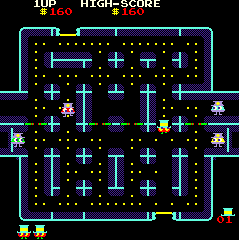Lock 'n' Chase
| Lock 'n' Chase | |
|---|---|
 Screenshot of Lock 'n' Chase | |
| Developer(s) | Data East |
| Publisher(s) | Data East, Taito |
| Platform(s) | Arcade Atari 2600 Intellivision Apple II Game Boy Wii PlayStation 3 3DS Virtual Console |
| Release date(s) | Arcade 1981 |
| Genre(s) | Maze |
| Mode(s) | Up to 2 players, alternating turns |
| Cabinet | Upright |
| Arcade system | BurgerTime hardware |
| Display | Raster, 240 x 240 pixels (Vertical), 8 colors |
Lock 'n' Chase is a 1981 maze arcade game developed and published by Data East in Japan in 1981, and was later published in North America by Taito. The game was later licensed to Mattel who produced the Intellivision and Atari 2600 home console versions in 1982 [1][2] and an Apple II version in January 1983.[3] Telegames later re-published the game for the Atari 2600 after acquiring rights from Mattel. Data East released a Nintendo Game Boy version of the game in July 1990. [4] Lock 'n' Chase was Data East's response to Pac-Man.
Gameplay
The game's main character is a thief. The object of the game is to enter a maze and collect all the coins and, if possible, any other treasure that may appear. The thief must then exit the maze (a vault) without being apprehended by the Super D (policemen). The thief can close doorways within the maze in order to temporarily trap the Super D and allow him to keep his distance from them. Only two doors can be closed at a time. The Super D policemen are named Stiffy, Scaredy, Smarty, and Silly.[5]
Coins (depicted as dots) are worth 20 points each. In every level of Lock 'n' Chase, there exist money bags that appear in the center of the maze randomly. Money bags are worth 500, 1000, 2000, and up to 4000 points, respectively, for each time they appear.[6] Each level also has a specific treasure that appears near the center of the maze (much like the food items in Pac-Man). These treasures include the following items (listed respectively by level): top hat, crown, briefcase, and telephone. The first three of these treasures are worth 200 points, 300 points and 500 points, respectively. Additional treasures and their point values are revealed as the player completes successive levels.[5]
This game was released in two different arcade game versions in the US. One was part of Data East's DECO Cassette system, a convertible system designed to change games out quickly by using a cassette and special key. It was also licensed to Taito for release. The Taito version used a dedicated motherboard and no cassette, and was made in very small quantities for a 1981 title (estimates by collectors place it at around 1200 units).[citation needed] This was the last Taito cabinet released in the "old style" cabinets; Taito's next arcade release, Qix, changed over to the familiar Taito cabinet style used until the mid-1980s.
The original Lock 'n' Chase began to appear at home in 2010, included in the Nintendo Wii release Data East Arcade Classics and a release on the PlayStation Network. The Game Boy version was released on the Nintendo 3DS Virtual Console on January 19, 2012.
References
- ↑ http://www.mobygames.com/game/intellivision/lock-n-chase
- ↑ http://www.atariage.com/manual_html_page.html?SoftwareLabelID=273
- ↑ http://www.intellivisionlives.com/bluesky/games/credits/computers.shtml
- ↑ http://www.nintendo.com/doc/dmg_games.pdf
- ↑ 5.0 5.1 http://www.klov.com/game_detail.php?game_id=8436
- ↑ http://www.intellivisionlives.com/bluesky/games/instructions/action/lock.txt
External links
- Lock 'n' Chase at the Killer List of Videogames
- Lock'n'Chase guide at StrategyWiki
- Intellivision Lives! - Action Network page - Lock 'n' Chase info
- Lock 'n' Chase at MobyGames
- Clone of the Atari 2600 version, for DOS.